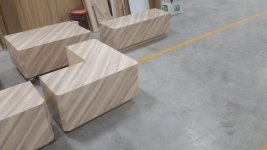I have considered getting one of those Betterley routers a couple of times, but I always seem to talk myself out of it? The concept is ok, but I can't see it working out right in actual application. On small items, it might work, but I don't do much small. Sure, if you needed to do some 8" cube, to sit on a desktop as a display of it's abilities, I bet it would do that just fine.
Do that as a drop edge on the front of a countertop? Everything would have to be perfect. It would need to be stuck, turned over, and lay on some thing that is flat, so that the unit is supported during the cut. That section sticking out needs to be clean, so you can route it. Since we spray contact cement, that would mean masking of some sort. Where you could brush a small part
You would never be able to use it on an inside corner, you can only use it up against a 90 degree face....etc. I just don't see the application where it would help me? But, as I said, still thinking about it, maybe one day, just for kicks?
On bigger pieces, like the last one with the radius meeting the corners, I pre-laminate the parts and Domino the corners together. I generally burnish the sharpness away with some ultra-fine sandpaper, but the risk is always there. If someone bangs into something like that reception desk with a cart of some sort or a vacuum cleaner, etc. it could very well chip, but the same can be said for a 90 degree corner, done in the traditional way.
With these, because they are so small (13"-15"long and only 1 1/2" wide) these didn't get or need that much support. They are simply taped and folded. The tricky bit is in getting every piece to the exact length to fit around an internal structure and fitting it all at once.
The "work for minimal reward" part, at least for me, is in the bad color choice. Of course, you need somewhat of a linear pattern for the angle to "work", but a wood grain that will always suffer from a kerf-loss mismatch no matter what, is bad enough. Color differences as bold as this make it worse. The available amount of length that can be cut from the sheet is very limited because of the angle, so matching around corners is impossible. On a pattern with consistent width lines, it can be done. As usual though, I have no control of that choice.
The really odd part is that there is another section of this whole unit where the grain is vertical. I didn't get a pic of that as a separate piece, but I will once it is done. I'm sure that it will look totally different once it is in-place and loaded up as a retail display. Yes, retail is always risky, anything could happen. I have had to repair damage to butcher-block cladding on hospital reception desks and that takes some doing.



